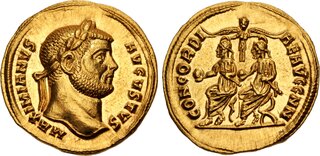| Classical Numismatic Group > Triton XXVII | Auction date: 9 January 2024 |
| Lot number: 871 Price realized: 25,000 USD (Approx. 22,898 EUR) Note: Prices do not include buyer's fees. | Show similar lots on CoinArchives Find similar lots in upcoming auctions on |
| Lot description: Maximianus. First reign, AD 286-305. AV Aureus (19mm, 5.43 g, 12h). Uncertain mint (Cyzicus or Antioch). Struck AD 293. MAXIMIANVS AVGVSTVS, laureate head right / CONCORDI AE AVGG NN, Diocletian and Maximian, both helmeted and draped, seated left on curule chairs, holding globe in extended right hand and parazonium in left, being crowned by Victory above. RIC V 601 (Cyzicus) and 615 (Antioch); Depeyrot 13/3 (Cyzicus); Calicó 4612; Biaggi 1771. Lustrous with proof-like fields, slightly wavy flan, thin reverse die break. Superb EF. Well executed dies. From the Willamette Valley Collection. Ex Triton XXIII (14 January 2020), lot 854; Pierre Bastien Collection (Numismatica Ars Classica 111, 24 September 2018), lot 214; Mme. Valette Collection (Rollin & Feuardent, 16 June 1924), lot 272. Aurei with the CONCORDIAE AVGG NN reverse are known for Diocletian, Maximianus, Constantius, and Galerius, placing this issue in AD 293, the year the First Tetrarchy was fully established with two junior rulers (Constantius I and Galerius as Caesars), and when Diocletian (for the fifth time) and Maximianus (for the fourth time) held the joint-consulship. Which mint struck these unsigned issues has long been debated. Pink, in laying out the gold issues of the First Tetrarchy, assigned the unsigned aurei to Cyzicus, including the CONCORDIAE AVGG NN reverse issue. Webb, however, assigned the coin to Antioch. Although he gave no specific reason for doing so, he did note in his discussion of the Cyzicus mint (p. 215) a close association between the two mints. He also noted referenced Pink's 1931 article ("Die Goldprägung des Diocletianus und seiner Mitregenten"), but did not incorporate its findings (p. 219). Since then, attributions for these unsigned issues have varied among numismatists and catalogers. One can see obverse stylistic affinities between these aurei and later marked issues of Antioch (Lukanc 5 [p. 175, 3]). Unfortunately, as Sutherland (RIC VI, p. 597 [Antioch]) points out in his discussion of the mint, these early issues have largely been studied out of context, and only a more detailed study of this early coinage will provide a more satisfactory answer. Estimate: 20000 USD |  |



